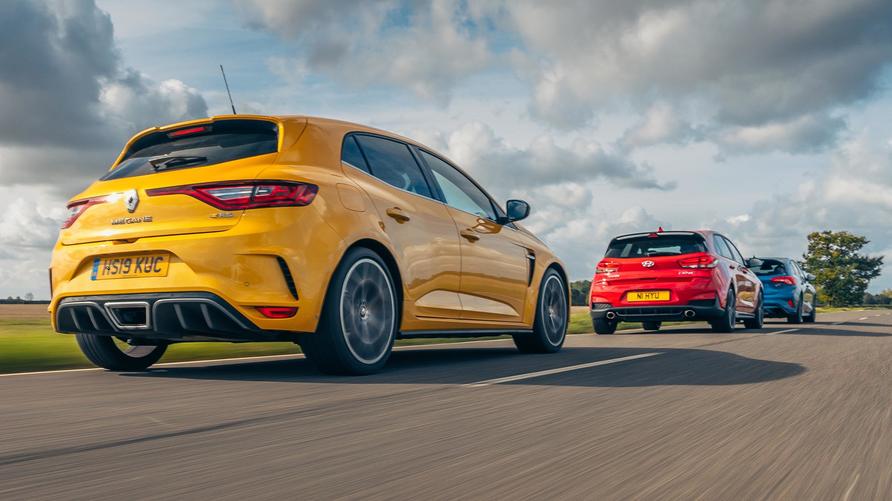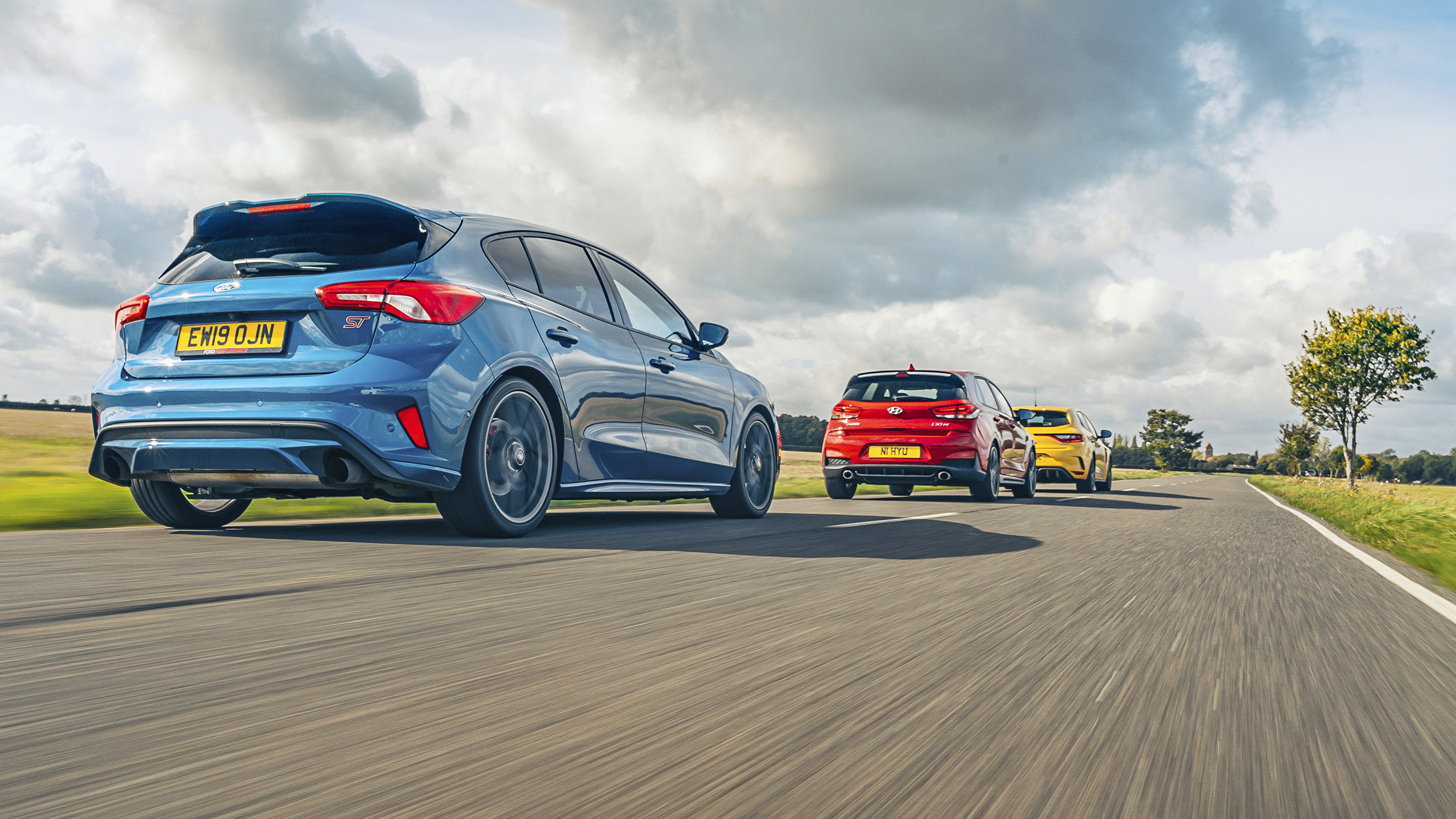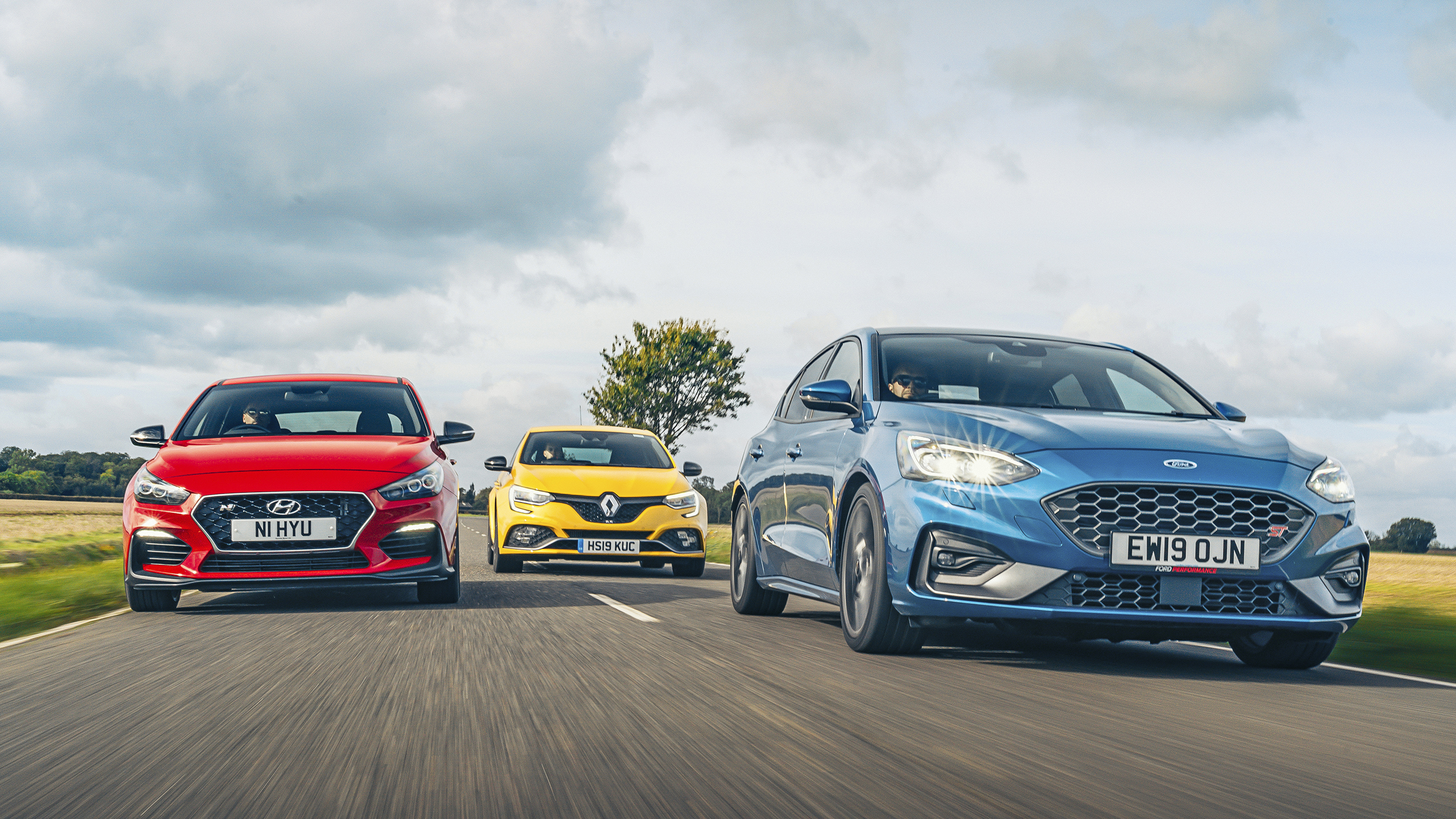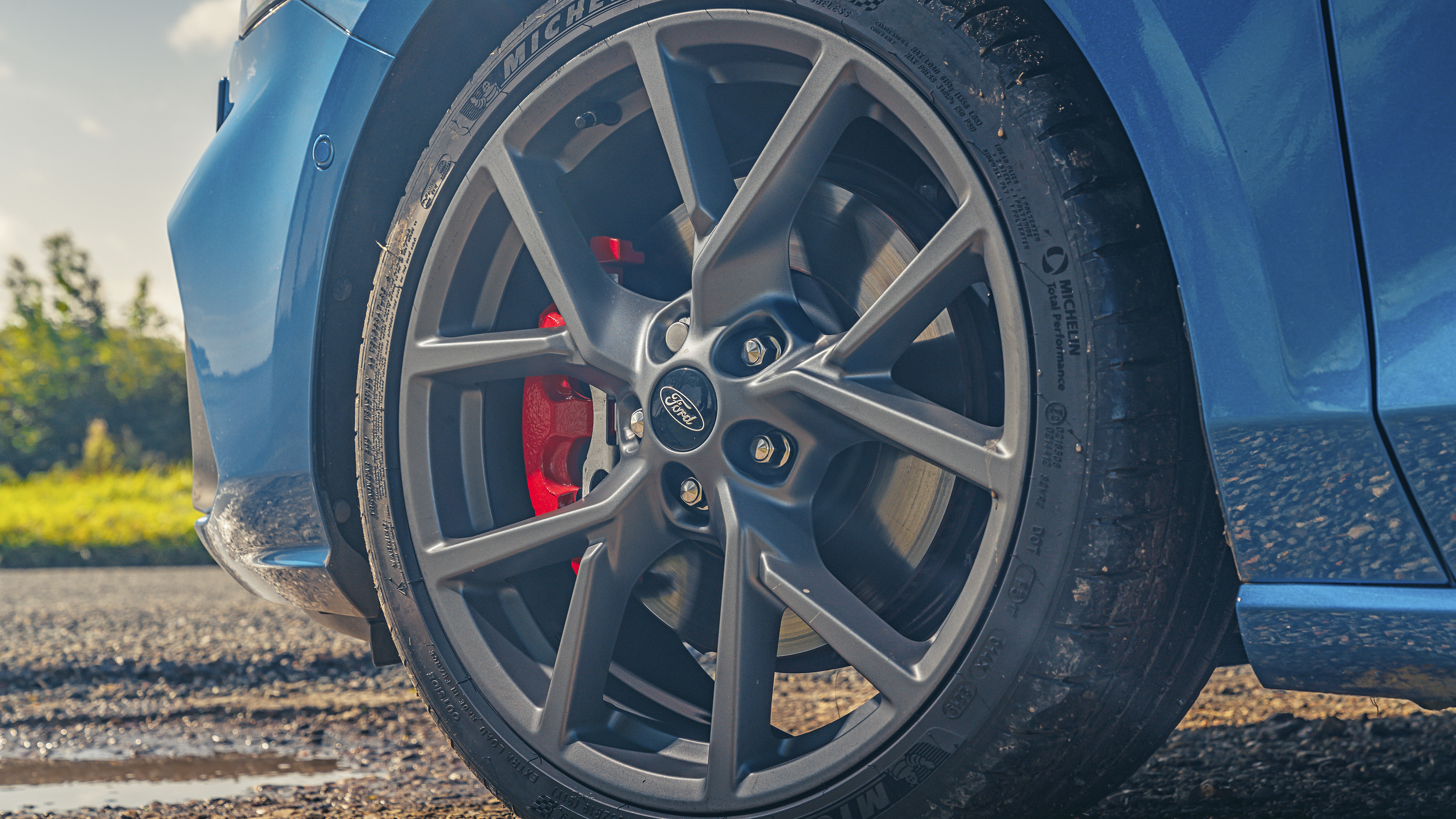
Ford Focus ST vs Renault Megane RS 300 Trophy vs Hyundai i30N
The latest fast Ford is a tech-obsessed 276bhp Focus. Should the RS Megane and i30N fear it?
You can’t please all of the people all of the time, but a hot hatch gives it a damn good try. A natural event horizon of utility versus fun-to-drive, a practical-only car that still manages to amuse when the situation arises. Except that hot hatches aren’t actually just ‘hot’ anymore. Bars have been raised, performance figures have punched happily through various ceilings, and the fastest now operate strictly under sports-car rules.
Words: Tom Ford / Photography: Mark Riccioni
Take these three for example: none are what could be called the most extreme of the breed, but all manage 62mph from rest in less than six seconds, hit 155+mph, run with locking differentials and switchable drive modes. Not one has less than 270bhp, all three would – if well driven on an unknown twisty road – seriously put the frighteners on a middle-aged supercar. All are, in a modern context, reasonably priced – although I wouldn’t go so far as to say that around £30k was actually cheap.
The newest is the latest generation of Ford’s Focus ST. A perennial favourite, now available in either hatch or estate and 188bhp diesel or the 276bhp, 2.3-litre petrol flavour we have here. More power, more kit, more technology than ever.
More money, too, weighing in at a smidge under £32k basic – albeit pre-loaded with plenty of kit. It faces off against the more committed Renault Megane RS Trophy (£31,385, 296bhp) and the exceptionally rounded Hyundai i30N Performance, which weighs in both a bit cheaper and just a shade less powerful at 29-and-a-half grand and 271bhp.
Bang on the money in terms of the 0–62 sprint (5.7 seconds for the RS and ST, 5.9 for the i30N), as near as legality-makes-no-difference for top speed (155mph each for the i30N and ST, 162 for the RS). But for all their similarities, these are three very different cars, with very different characters. Let me explain.
Back in the olden days, probably the early Nineties, it was common knowledge that if you tried to put more than about 200bhp through the front wheels of a car, you’d end up in a ditch wearing said front axle as a scarf. This is now not the case. All three of these cars are more than capable of applying their turbocharged power to the road without immediately dislocating both wrists, or instantly bonfiring an unweighted tyre.
They are all fantastically capable of throwing themselves down a B-road or racetrack – as mentioned, the baseline of hot hatchery has been generously upgraded. It’s the Focus that feels the most grown-up from the start, though. It’s a shade bigger than the other two (rear legroom notably better for tall knees), and the way it moves down the road makes it feel like a bigger car. That’s not to say that it feels paunchy by any stretch, a whipcrack steering rack and rock-solid body control mean you can pitch the ST into an unknown bend and have all sorts of overconfidence.

Switch between modes in this Performance Pack equipped car and it variously ramps up its responses in terms of engine and throttle response, firmness of damper and tendency to backfire on the overrun, eventually goading you into a place where you’ll be grinning like a mad thing. The relatively large 2.3-litre four feels brawny and capable, gives off a decent (amplified) warble and you can surf the rev-counter rather than hammering it to the red line. Although it’s more than happy if you do.
The electronic locking diff is quick and direct, and it’ll keep the nose pointing in the right direction even if you’ve slightly overestimated entry speeds. This is all good stuff – it’s fun without being tiring, capable without huge sacrifice when you’ve got to trawl the motorway. It also looks demure, with only a 10mm drop versus the next-in-line Focus ST Line and some subtle ST badging and wheels – it’s not a shouty-looking car, especially in a modest colour.
The Megane is a total yoof in comparison. The eye-gouging yellow paint probably doesn’t help, but Renault hasn’t slacked in making the RS look special. Swollen arches, a couple of vents, centre-exit exhaust – this is a car that is obvious in intention. And its intention is to be driven hard, all the time. Because the Megane positively loves to be thrashed.
Admittedly, it did backfire so violently at times that I thought something had fallen off mid-corner, it sounds like an industrial fan and you have to play with the settings of the 4Control four-wheel-steering system to stop it feeling like it’s always about to oversteer you into a field, but there’s something lightly joyous about threading three or four fairly tight bends together in this small Renault hot hatch – it flows. Body control is excellent, balance is pretty peerless, the relationship between steering wheel and actual trajectory eminently satisfying. It’s the most playful, the most engaging on the right road, and feels like a real little terrier of a car. But you do have to push it – the 1.8-litre four may have similar outputs to the Focus, but you have to earn them, and that makes it less relaxing, all of the time.
Top Gear
Newsletter
Thank you for subscribing to our newsletter. Look out for your regular round-up of news, reviews and offers in your inbox.
Get all the latest news, reviews and exclusives, direct to your inbox.
The Hyundai sits somewhere in-between: more mature and less excitable than the RS, not as fluid as the ST. It looks purposeful, but not as in-yer-face as the Renault. But when you push it, there’s real talent here. Yes, in ‘N’ mode it’s ridiculously hard – it actually flicks the car into the air over bad B-road bumps – but get the timing right and the trade-off is a laugh-out-loud hot hatch.
In the Nineties, if you tried to put more than 200bhp through the front wheels, you’d end up in a ditch wearing said front axle as a scarf.
The excessive popping and chuntering from the exhaust seems par for the hot-hatch course, but it is fun, even if it feels a bit childish at first. The steering is bang-on – impressive from all three cars – the body control, exceptional. In fact, the Hyundai feels very much like a slightly oversprung Golf GTI: neat, useful, compact in its attitude and responses. It also never really feels down on power, despite giving away the best part of 25bhp to the Megane – it just gets up on its toes and goes.
Truth be told, none of these three would be left for dead by any of the others. They may have different dynamic characters, but you’d just pick the one that suited you the most emphatically. The battle, therefore, is probably won in the detail, rather than the headlines. All three have very good brakes; all three very good steering. But the Megane’s gearshift action is absolutely horrible in this company, a manual ’box that manages to be accurate yet feel as if it’s been built exclusively out of leftover bits of water pistol.
The rest of the interior is fine, but doesn’t feel particularly special, even with the large portrait touchscreen. The Focus, on the other hand, has a gearchange that could do with being a bit more positive, and a throttle pedal that needs a stiffer spring – it kind of faints away from your foot. Mind you, I’d buy the Focus for the excellent – and standard – Recaro seats alone. The rest is a bit take-it-or-leave-it: some nice features, but it feels slightly haphazard – and typically Ford.
The Hyundai scores here. It’s not an inspiring interior, but it is extremely practical and nicely built, feeling very much like this car was benchmarked against the good stuff. Which it was. The control surfaces are by far the best matched, and it has the nicest gearshift by a mile. And while all cars are well-equipped, the Hyundai manages to have all the kit you reasonably want for a couple of grand less – not an insignificant amount in this market.
Which makes a conclusion a properly hard decision. There’s a big chance that the car you buy will be heavily influenced by the kind of deals you can get on monthly schemes, and some of that is still to be decided – if that’s the case, then there’s not a ‘must-avoid’ car in this test.
The Megane is the car if performance is your primary criterion. It’s fun, fast and purposeful-looking, certainly has the chops for the odd track day and feels punky and energetic.
But gets let down on the smaller things: the gearshift action – in what is the most sports-orientated car. The Focus ST is the more mature hot hatch. It’s fluent, easy and capable, with a defined edge that emerges when you press on. In many ways, it’s the perfect ST – not as hardcore as a Focus RS, but with defined and well-sorted dynamic character. It would be a breeze to live with, coming equipped with a wider breadth of ability than the Renault.
Which leaves the i30N. This is the car that wins on points. Hyundai might not have the desirable back catalogue or image, but you can’t argue with the value that the i30N delivers.
It’s stupidly hard in N-Performance mode, and there are a few rough edges that need smoothing out... but it’s got all the things a decent hot hatch needs, plus a bit of surprise and delight. Not a knockout victory, but a win’s a win.
Trending this week
- Car Review
BMW 1 Series
- Top Gear's Top 9
Nine dreadful bits of 'homeware' made by carmakers











